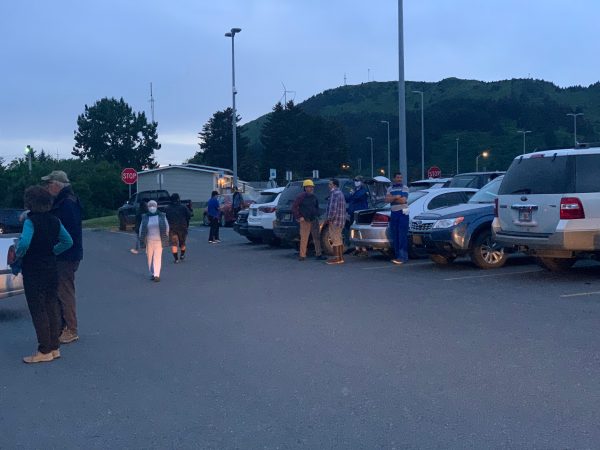
Update, 12:30 a.m.:
A tsunami warning for a stretch of coastal Alaska has been canceled. NOAA’s National Tsunami Warning Center said the tsunami is no longer a threat. It reported a 24-centimeter wave at Sand Point. “Some areas may continue to see small sea level changes,” the center said.
Original story:
After an Aleutian earthquake prompted a tsunami warning Tuesday night, residents across coastal Alaska, from Homer to Unalaska, woke to the sounds of sirens and phone warnings and many quickly left home, moving to higher ground.
The magnitude-7.8 earthquake occurred around 10:15 p.m. Tuesday, south of Chignik.
Soon after, the National Tsunami Warning Center issued a warning for coastal Alaska from Kennedy Entrance, 40 miles southwest of Homer, to Unimak Pass, 80 miles northeast of Unalaska. The center predicted that Sand Point, Cold Bay and Kodiak could see waves within hours.
Sirens blared.
In Sand Point, residents gathered in the school. They all wore masks, and people were calm, said D.J. Emanuelson, the principal.
“We haven’t seen a wave yet,” Emanuelson said Tuesday night. “I’m looking right now at the parking lot, the police are out there and they’re just looking off into the distance, into the ocean. But there’s no excitement here yet.”
Sand Point was the first community predicted to see a wave.
But, by 11:30 p.m., it had recorded only a “very small” wave, said James Gridley, the director of NOAA’s National Tsunami Warning Center in Palmer. Gridley estimated the wave was about 25 centimeters.
He said it was too soon to say what size wave Kodiak and Cold Bay may see but, “likely small if we’re already seeing small at Sand Point.”
“We’re not expecting a massive wave anywhere,” he said.
On the Kenai Peninsula, Tracy Crowley, a teacher from Chicago, was in her hotel near the Homer Spit when she got the tsunami alert. She called the front desk but didn’t get much information.
“They said they had no idea what the protocols were, that she was looking into it and that her manager was on the way and we could call back.”
But then the sirens sounded. Crowley and her friend got nervous. They threw some of their belongings in the car and started driving toward high ground. They didn’t know where to go and ended up on Diamond Ridge Road, parked in their rental car for hours, scrolling for information on their phones, they said.

Meanwhile in Kodiak, Schools Superintendent Larry LeDoux stood outside of the local high school and handed out masks to people entering the evacuation site.
By 12:15 a.m., he said the atmosphere inside was calm as people waited for news.
“I’m seeing a lot of relaxed people standing around, just sitting in bleachers or shooting hoops or a lot of people just sitting around outside and enjoying the nice weather,” he said.
Test tsunami sirens go off every Wednesday at 2 p.m. in Kodiak and, LeDoux said, the city has a “well-oiled system” for evacuations.
“Just a wonderful example of Alaska during a crisis,” he said. “We just work together and take care of each other.”




